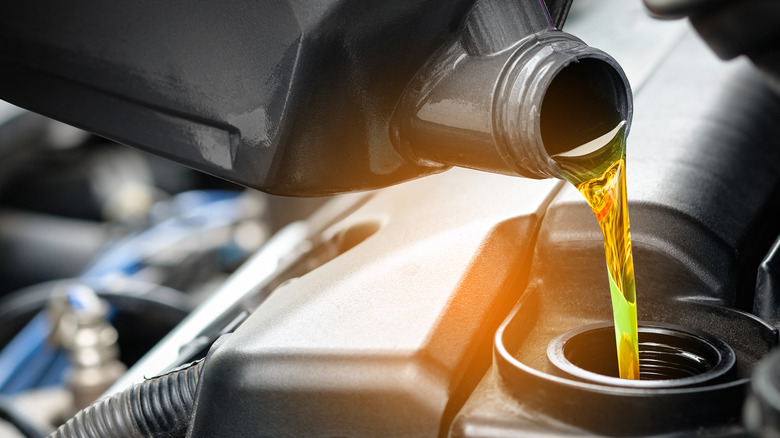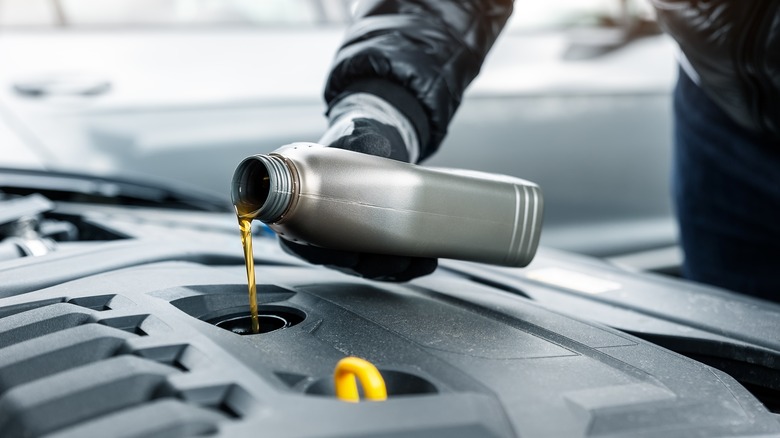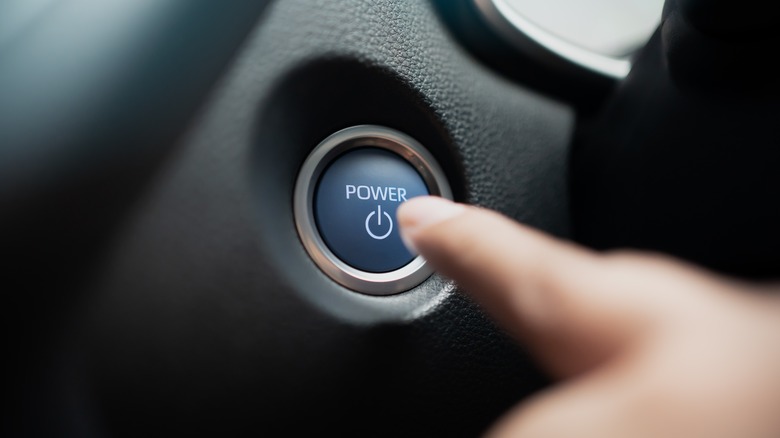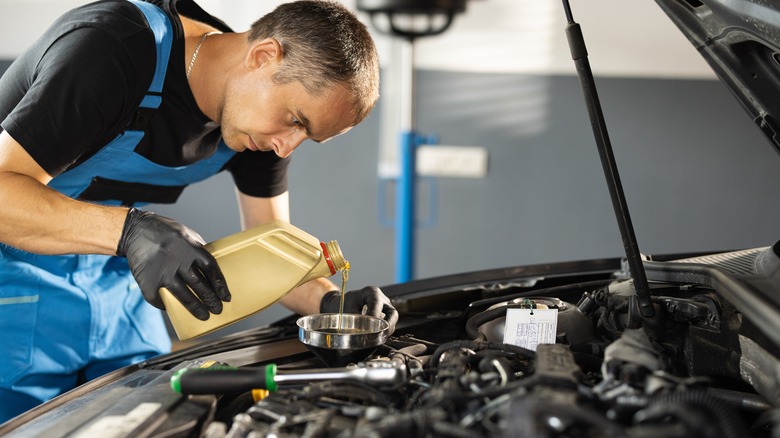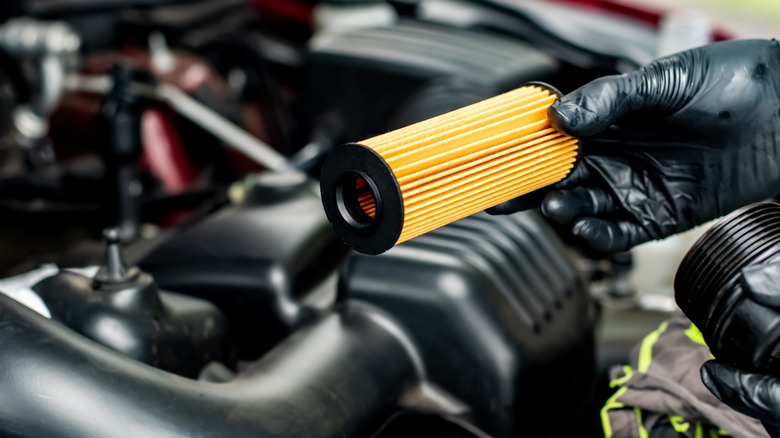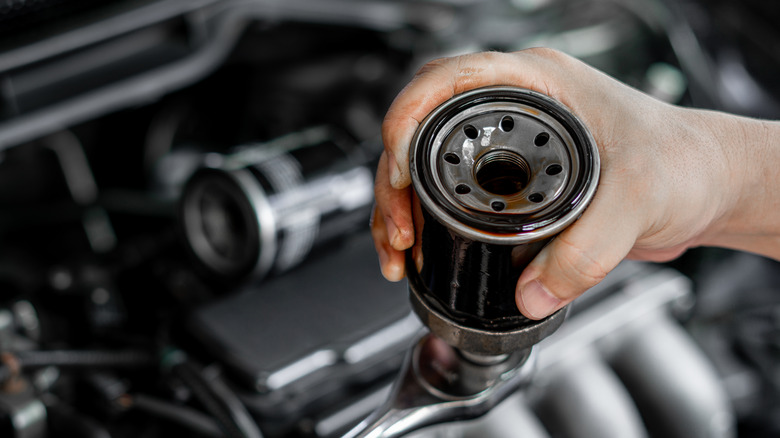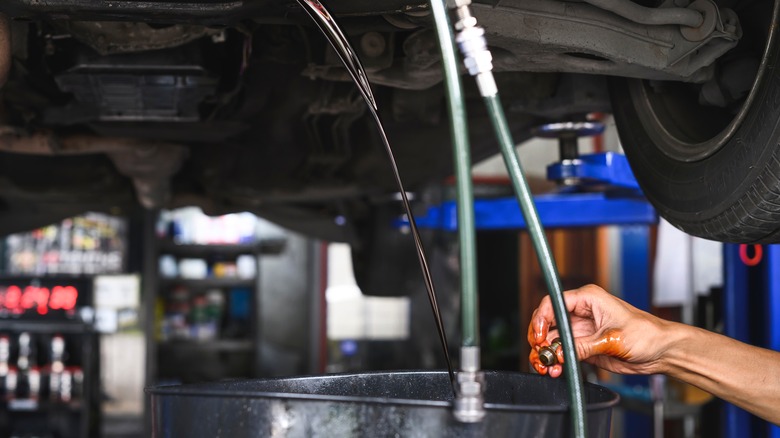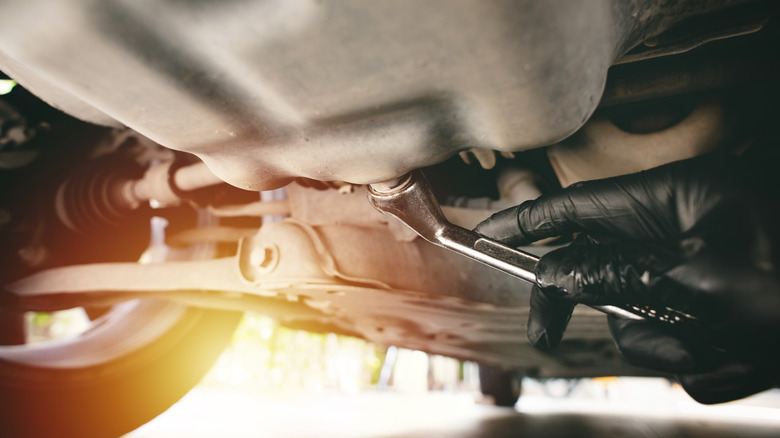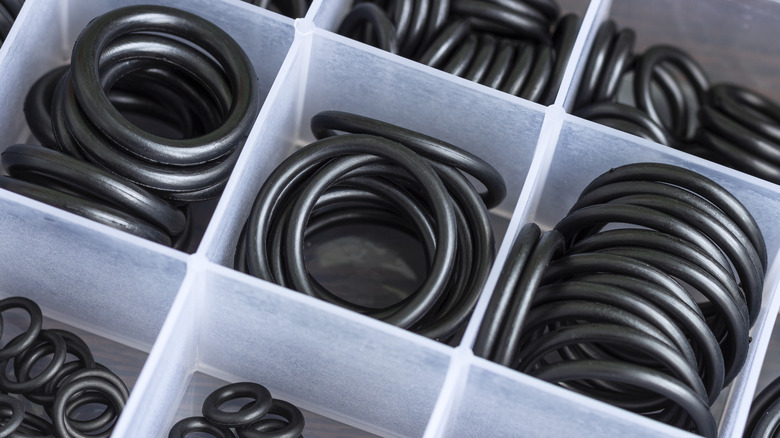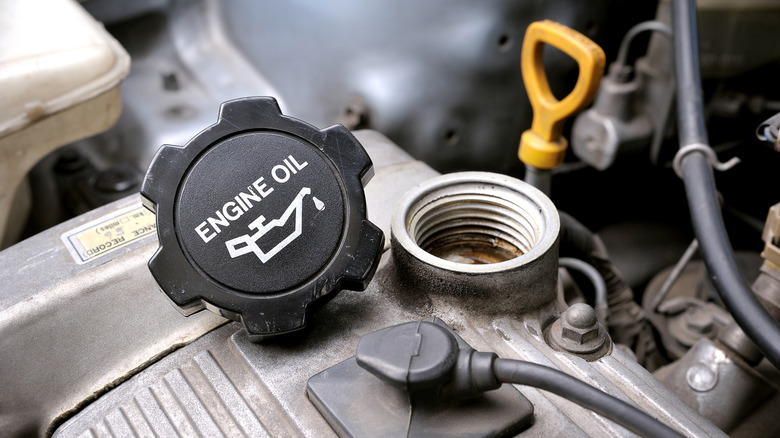10 Mistakes You Might Be Making When Changing The Oil In Your Vehicle
Regularly changing the oil in your vehicle is one of the most basic yet important maintenance tasks. You can take it to a local auto shop to have a professional handle it or try to save a few bucks and do it at home. Before going the DIY route, it's worth considering if it's actually cheaper to change a car's oil yourself — it depends on what tools you already own and what type of car you drive. Either way, it needs to get done because ensuring there's clean oil in your car allows the engine to last longer and perform better.
Over time a car's oil deteriorates, becoming incapable of lubricating all of the components as it should. This can lead to worse gas mileage and shorten the car's overall lifespan. There's nothing wrong with changing the oil yourself if you know what you're doing, but many people don't. One mistake can ruin the entire process, costing you more money in the long run and potentially damaging your engine.
Changing oil is a DIY auto project beginners can handle, just heed these warnings first. These are some of the most common mistakes people make when changing their car's oil, so you should know what to look out for to avoid taking your vehicle to an auto shop to explain (and pay for) what you did poorly.
Not getting oil changed frequently enough
There tends to be confusion with how often someone actually needs to change their car's oil. The old guideline is pretty firm: This task should be done every three months or every 3,000 miles. However, advancements in automotive technology mean most people can go a bit longer. Depending on your kind of vehicle and what kind of oil it takes, you might be able to go between 5,000 and 7,500 miles (or six to 12 months) before you need to change the oil again. Your car's owner manual will tell you exactly the timeframe to keep in mind for this task, and it's vital to follow it.
Generally, it's a good idea to change your oil at least twice a year. Even if you don't drive a lot and the car sits in the driveway most of the time, the oil can still degrade depending on the temperature outside. Towing heavy loads with your car can also degrade oil faster, so even if your car normally needs a change at 5,000 miles, it could need it sooner.
More modern vehicles even have dashboard alerts that inform you whether it's time for an oil change. It's always a good idea to follow the warning and replace the oil as soon as possible to prevent any issues from building up. You never want to skip an oil change, as it increases the risk of sludge build-up, which ends up adding to the total cost when it's finally addressed.
Using the wrong kind of oil
Motor oils differ greatly. If you take your car to an auto shop, the workers should know what oil is best, but DIYers need to be aware of it on their own. There are a few different varieties: conventional, high mileage, synthetic, and synthetic blend. A lot can go wrong if you use the wrong type of motor oil — again, your owner's manual will tell you what type is best.
The wrong oil could significantly harm your vehicle's fuel economy. If the engine isn't operating as well as it could, it'll require more gas, which means you'll find yourself at the pump more often than you would like. But that's only the beginning, especially if a person continues to use the wrong oil repeatedly. The wrong oil may not have all the additives your engine requires, which can lead to extreme wear and tear, and eventually total engine failure. Some car warranties become void if it's proven you used the wrong oil.
When in doubt, consult your manual or ask a professional. Some people may feel inclined to use a different oil because it costs less. For instance, synthetic oil can sometimes cost twice as much as conventional. But the price of replacing an engine will make anyone wish they had just used the more expensive oil in the first place.
Failing to warm up the engine first
Letting a car warm up before driving it in the cold is a myth. Modern cars don't need a few minutes to get things going before heading out on the road. However, one instance where you should let your vehicle warm up initially is right before an oil change.
The Seattle Times does a good job of explaining why it's important to let your engine run for a bit before proceeding: "The five-minute rule is a good one. You warm up the oil so it's less viscous and it flows better. That way, less of the old oil remains inside the engine — stuck to the walls of the oil pan and other engine parts."
Warmer oil flows more easily and is more likely to take away any gunk as it flows out. You can certainly drain your car's oil without warming it up, but you may need to wait a bit longer for it to fully drain, and you may not get everything that could hamper your engine's functionality.
Granted, you don't want the oil to be too hot and risk burning yourself. Therefore, if you want to change your oil immediately after a drive, it'd be recommended to wait about 30 minutes for it to cool. From there, you simply remove the drain plug and let gravity do its thing. This paves the way for the new oil to come in with as minimal debris as possible in the engine.
Putting in too much or too little oil
A good way to determine whether your car needs an oil change is to check the levels to see if there's too little in the engine. Underfilling the oil means there's going to be more friction, and various engine parts aren't going to be as well-lubricated. This makes it difficult to attain proper acceleration, and your car may not be able to go up hills or get to the speed you want on the freeway as easily. It's important to replace your oil with a sufficient amount, too — otherwise, you'll be right back where you started.
On the other hand, you run into just as many issues when you overfill an engine with oil. Too much oil increases the risk of it coming into contact with the crankshaft, which means oil could enter the exhaust pipe and clog it over time. It can also lead to an increase in pressure, causing damage to engine gaskets and seals, potentially paving the way for a leak.
There are some telltale signs that someone has filled up with too much oil, including the engine emitting odd noises and smoke coming out of the tailpipe. At the risk of sounding like a broken record, you should look at your owner's manual. It will tell you how much oil your car's engine needs. Most engines require anything from 5 to 8 quarts (4.7 to 7.5 liters) of motor oil — you don't want to guess and get it wrong.
Forgetting to install a new oil filter
Your car needs more than new oil once in a while. With every oil change, you should also install a new oil filter, which helps prevent dirt, debris, and gunk from circulating around the engine, and ensures clean, efficient oil goes through. If you change the oil but keep the same dirty filter in place, you might as well not have changed the oil at all because sludge and other contaminants will get everywhere. The engine won't be as lubricated as it should be, and there's a greater risk of overheating.
A full-service oil change at a shop should come with a new filter, but it's one more thing to purchase when doing it yourself. You want to make sure you get a full-flow filter, which is the main device used to grab any impurities in the oil. Additionally, some vehicles require secondary oil filters, which are in place to try to catch anything that might've been missed from the main filter. You'll need to make sure to check what your car needs so that you have everything ready before moving forward with the job.
Fortunately, you can replace an oil filter without having to replace the oil. In the event you forget, you can always go out and buy one without having to do everything all over again.
Installing the new oil filter incorrectly
There's a right way and a wrong way to install a new oil filter, and doing the latter can have serious consequences. One of the more common issues basically amounts to putting it in too tightly. It should be secure, but going too far can lead to stripping the threading or busting the O-ring. If the O-ring breaks, there's not going to be an adequate seal to ensure the oil goes where it needs to. This can lead to leaking.
One tip to reduce the chances of something going wrong during the oil filter installation is to lubricate the new O-ring first. The O-ring also needs to be replaced any time you do an oil change, and a fresh one typically comes with new filters. Use oil to wet the O-ring so that it can better withstand the torque affiliated with tightening the filter.
With this step, it's vital to ensure you have the right oil filter. Just like you wouldn't put on the wrong size tires for your car, you don't want to use a filter that isn't suitable. You want to ensure it has the proper height, gasket size, and thread size for your make, model, and year of vehicle. It's also generally ill-advised to opt for an aftermarket filter, as there could be something wrong with it you're unaware of. New oil filters are fairly inexpensive already, so there's no need to cut corners.
Overtightening the oil drain plug
After you drain all of the old oil from your car, but before you put in new oil, make sure the oil drain plug is securely in place. Typically, there's simply threading to get the plug where it needs to be, and a lot of DIY mechanics may want to make sure it's in there tight by going too far. But this actually does more harm than good and could lead to a very expensive repair down the line.
You may be tempted to use an air tool to ensure the plug isn't going anywhere, but you can generally do this by hand. And when you feel it not getting tighter anymore, that's when it's time to stop. Continuing to try to tighten it will make it feel looser. This will damage the threading, and when it comes time to drain the oil a few months later, you may find that it's impossible to remove due to cross-threading. At that point, you'll need specialized tools to try to get the plug out. More often than not, people will be better off simply installing a whole new pan altogether.
It's understandable people would be concerned about an oil drain plug being too loose. It can cause leaking or rattle around before coming undone entirely. The Goldilocks principle is on full display by ensuring it's in there just right before moving on.
Failing to replace the drain plug gasket
The drain plug gasket is a critical component to prevent oil leaks in your vehicle. Yet again, it's small and easy to overlook, but in general, people should get a new one with each oil change. Depending on the type of car, some people might be able to get away with replacing it every other time. However, seeing as they usually only cost a few bucks, it's probably worth it just to get a new one every time.
The gasket can warp and break down over time, increasing the risk of a leak. Of course, there also are a ton of people in online forums talking about how they've driven their cars for over 100,000 miles and never replaced the drain plug gasket for an oil change. That anecdotal evidence should be taken with a hefty grain of salt, and it does appear that certain types of vehicles require more frequent changes than others. When in doubt, play it safe.
An old gasket won't work as well, and Redditor u/GotMyOrangeCrush provides this salient point: "Reusing the washer is how folks end up stripping the pan threads because they end up having to put the bolt on tighter and tighter to make it not leak." Don't try to save a couple of dollars by reusing a gasket; it could create even larger headaches later.
Forgetting to lube the new filter gasket
Previously, it was touted as good advice to lube the O-ring before installing it alongside a new oil filter. Lubing is also a good idea when putting a new filter gasket in the system, for the same reasons. Lubrication makes the gasket simpler to fix into place by allowing the gasket to better withstand the torque, and it'll be easier to remove when the time arrives for another oil change.
While some oil change mistakes can lead to catastrophic results, there's no reason to fret too much if you forget this step when doing a DIY job. Unless you realize you have an oil leak, it's probably a safe bet the gasket is in there just fine, so you can leave it there until you have to deal with it again. In many instances, there's a little oil on the filter housing surface anyway, so it may have received a little lubing without you realizing it. The only issue here is if you're someone who likes to wipe everything down to keep it clean-looking. Even then, this is more of a task to make things easier on yourself (or a mechanic) in the future.
Failing to reinstall the engine oil fill cap
Once you're ready to take your vehicle back on the road, and a successful oil change has lulled you into a state of automotive euphoria, it's easy to overlook putting the engine oil fill cap back on. This is dead simple — just screw it back on. If you don't, when you start your car, oil can spew everywhere, and make you have to undergo the whole oil change process again.
Go look up a picture of what you can expect from not putting the cap back on — it isn't pretty. Oil will get all over the engine and inside of the hood. Since you need to be certain you have the correct amount of oil in your vehicle, you'll have to go through the entire process again to make sure you don't have too much or too little. Draining what oil is left is also recommended because you have no idea if dirt or other debris may have gotten in with the cap off. That's not even getting into the heavy-duty cleaning job ahead of you to get rid of all the blasted-off oil under the hood.
Learning how to perform an oil change on your own is a great skill. If you know what you're doing, you can save a bunch of money over the years compared to taking your car to a shop. Just avoid these mistakes so that you don't end up giving yourself even more work.
